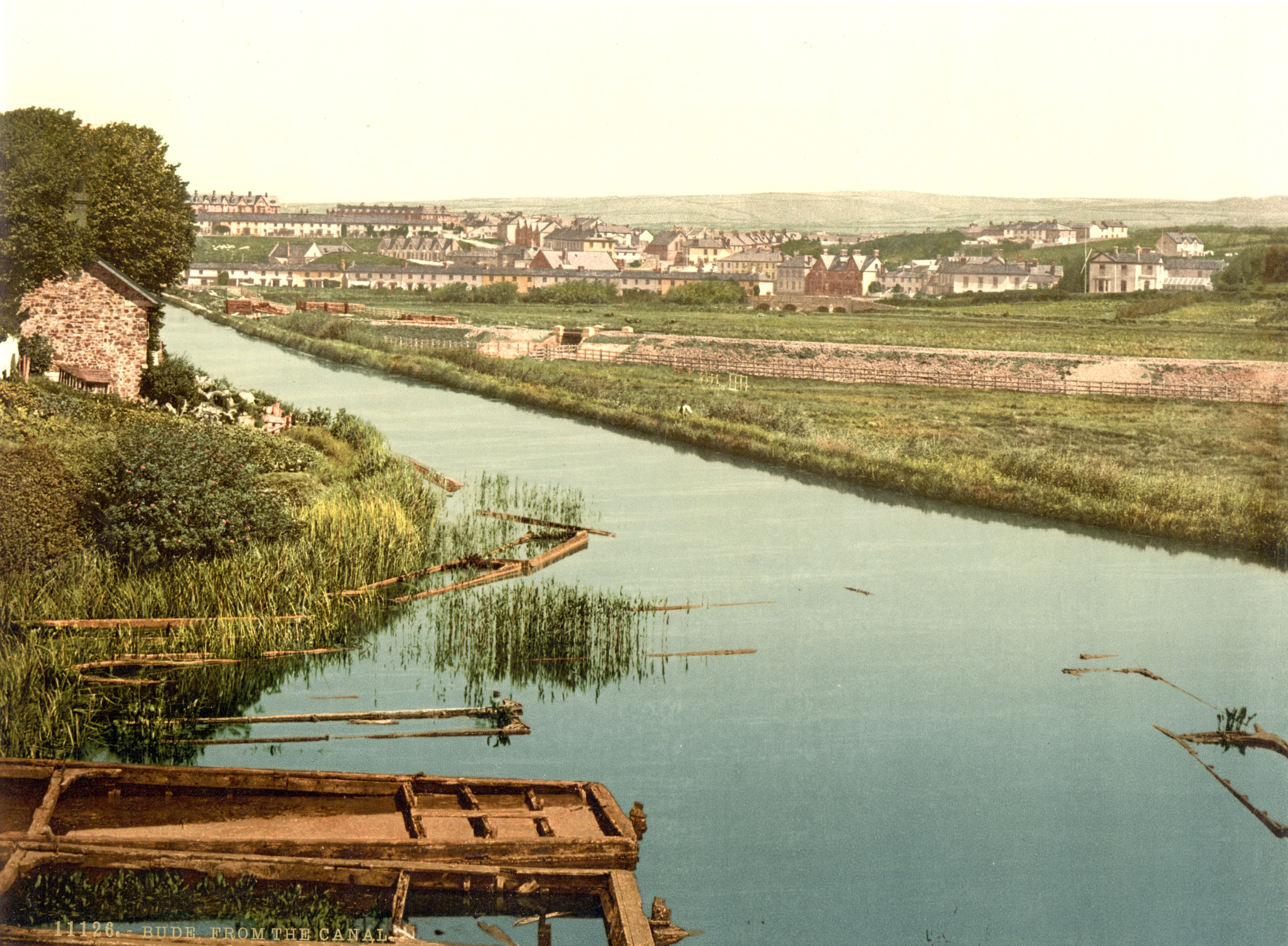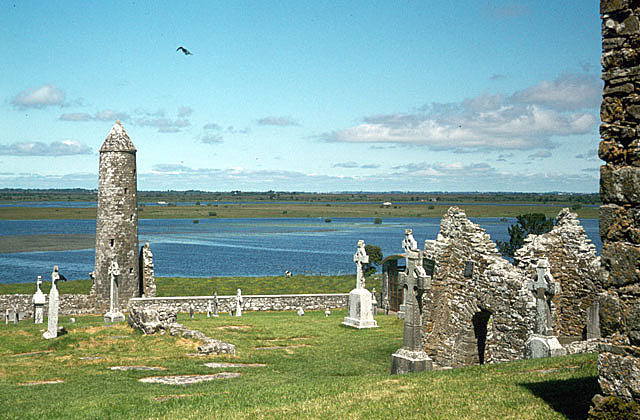|
Dukart's Canal
Dukart's Canal was built to provide transport for coal from the Drumglass Collieries to the Coalisland Canal in County Tyrone, Ulster, Ireland. It opened in 1777, and used three inclined planes, rather than locks, to cope with changes in level. There is little evidence that it was ever used, as the planes could not be made to work properly, and they were dismantled in 1787. History Coal seams were discovered at Drumglass, near Coalisland, in the 1690s, and the Tyrone coalfields were seen as a way to reduce the amount of coal imported to Dublin, then amounting to between 60,000 and 70,000 tons per year. Thomas Knox, an owner of one of the collieries, petitioned the Irish Parliament in 1709, to advocate the cutting of a canal to enable the resource to be transported more easily. The canal would have followed a similar route to the later Newry Canal, but nothing came of the plan, although it was well received. The scheme was revived in 1727, and assessed by the Surveyor-General in ... [...More Info...] [...Related Items...] OR: [Wikipedia] [Google] [Baidu] |
Davis Ducart
Davis Ducart (active from c. 1761, died 1780/81), was an architect and engineer in Ireland in the 1760s and 1770s. He designed several large buildings and engineering projects. He had associations with the canal builders of the time and the mining industry and worked on many projects in the County Tyrone coalfield. Early life and identity His origins are uncertain, but thought to be Piedmontese and/or Sardinian his original name was Daviso de Arcort. No relatives were mentioned in his will. Richard Killeen (2012) states that Ducart was an architect from Sardinia. Major projects in Ireland In the mid 1700s Ducart worked as an engineer on the Coalisland Canal (known as Dukart's Canal) and the Newry Canal which linked County Tyrone coalfields to further navigation at Coalisland. In Limerick Ducart produced the plan of plots to be leased in the Georgian extension of the city known as Newtown Pery and also those of the Custom House (1769), now home to the Hunt Museum. Other buildi ... [...More Info...] [...Related Items...] OR: [Wikipedia] [Google] [Baidu] |
Tub Boat
A tub boat was a type of unpowered cargo boat used on a number of the early English and German canals. There was no standardisation of tub boat size between different canals, but a typical English tub boat canal might have used boats around long and wide and generally carried to of cargo, though some extra deep ones could carry up to . They are also called compartment boats or container boats. The main virtue of tub boats was their flexibility. They could be drawn in trains of 3-10 or more boats using horse power, or later steam tugs, where the number of boats was varied according to the type of cargo. Tubs could be lifted more easily than larger boats and tub boat lifts and inclined planes were developed as an alternative to canal locks, particularly in or near a colliery or similar industrial works. At a lift the train could easily be divided, the boats lifted individually, and the train reassembled afterwards. Sometimes the boats used snug-fitting non-waterproof inner ... [...More Info...] [...Related Items...] OR: [Wikipedia] [Google] [Baidu] |
Canals Of The United Kingdom
The canals of the United Kingdom are a major part of the network of inland waterways in the United Kingdom. They have a History of the British canal system, varied history, from use for irrigation and transport, through becoming the focus of the Industrial Revolution, to today's role of recreational boating. Despite a period of abandonment, today the canal system in the United Kingdom is again increasing in use, with abandoned and derelict canals being reopened, and the construction of some new routes. Canals in England and Wales are maintained by List of navigation authorities in the United Kingdom, navigation authorities. The biggest navigation authorities are the Canal & River Trust and the Environment Agency, but other canals are managed by companies, local authorities or charitable trusts. The majority of List of canals of the United Kingdom, canals in the United Kingdom can accommodate boats with a length of between and are now used primarily for leisure. There are a number ... [...More Info...] [...Related Items...] OR: [Wikipedia] [Google] [Baidu] |
Canals Of Ireland
:''This article covers the whole of Ireland, that is, covering both the Republic of Ireland and Northern Ireland'' Navigable canals * Ardnacrusha Canal * Grand Canal * Jamestown Canal * Lecarrow Canal *Newry Ship Canal *Royal Canal *Shannon–Erne Waterway * Tralee Ship Canal *Barrow Navigation Derelict canals * Athlone Canal *Ballinasloe Canal * Boyne Navigation *Bridgetown Canal *Broharris Canal * Coalisland Canal (Tyrone Navigation) * Cong Canal (Dry Canal) * Dukart's Canal * Eglinton Canal * Lacy's Canal *Lismore Canal * Kilkenny Canal * Killaloe Canal & Plassey–Errina Canal * Lagan Canal (Lagan Navigation) *Newry Canal * Park Canal * Strabane Canal *Ulster Canal Filled-in branches or spurs * Grand Canal Harbour (near St. James's Gate) branch, Dublin * Royal Canal branch to Constitution Hill harbour, Dublin (aka the Broadstone line) See also Navigable rivers * Barrow Navigation *Lower Bann Navigation *River Foyle *River Lagan *Lee Navigation *Munster Blackwater & B ... [...More Info...] [...Related Items...] OR: [Wikipedia] [Google] [Baidu] |
Ashlar
Ashlar () is a cut and dressed rock (geology), stone, worked using a chisel to achieve a specific form, typically rectangular in shape. The term can also refer to a structure built from such stones. Ashlar is the finest stone masonry unit, and is generally rectangular (cuboid). It was described by Vitruvius as ''opus isodomum'' or trapezoidal. Precisely cut "on all faces adjacent to those of other stones", ashlar is capable of requiring only very thin joints between blocks, and the visible face of the stone may be Quarry-faced stone, quarry-faced or feature a variety of treatments: tooled, smoothly polished or rendered with another material for decorative effect. One such decorative treatment consists of small grooves achieved by the application of a metal comb. Generally used only on softer stone ashlar, this decoration is known as "mason's drag". Ashlar is in contrast to rubble masonry, which employs irregularly shaped stones, sometimes minimally worked or selected for simi ... [...More Info...] [...Related Items...] OR: [Wikipedia] [Google] [Baidu] |
Newmills
Newmills is a small village in east County Tyrone, Northern Ireland, from Dungannon and from Coalisland. Newmills gets its name from a corn mill and kilns that formerly stood in the area. Local amenities include a primary school, a local shop and a number of churches. It currently has a population of approximately 400 people. The River Torrent flows through the village. Places of interest *Annaginny Fisheries is a stocked and managed fishery. *Roughan Castle was built in 1618 by Sir Andrew Stewart. *Newmills Presbyterian Church. Politics *Newmills is in the Dungannon and South Tyrone Borough Council area at the geographic centre of the Torrent ward. Sport *Association Football is most popular local sport, and a number of teams from Newmills enter local leagues in the South Tyrone area. People *Robert Morrow (VC), Robert Morrow, received the Victoria Cross for bravery on 12 April 1915 near Mesen, Messines, Belgium during World War I. He was killed in action on 26 April 19 ... [...More Info...] [...Related Items...] OR: [Wikipedia] [Google] [Baidu] |
River Shannon
The River Shannon ( or archaic ') is the major river on the island of Ireland, and at in length, is the longest river in the British Isles. It drains the Shannon River Basin, which has an area of , – approximately one fifth of the area of Ireland. Known as an important waterway since antiquity, the Shannon first appeared in maps by the Graeco-Egyptian geographer Ptolemy ( 100 – 170 AD). The river flows generally southwards from the Shannon Pot in County Cavan before turning west and emptying into the Atlantic Ocean through the long Shannon Estuary. Limerick city stands at the point where the river water meets the sea water of the estuary. The Shannon is tidal east of Limerick as far as the base of the Ardnacrusha dam. The Shannon divides the west of Ireland (principally the province of Connacht) from the east and south (Leinster and most of Munster; County Clare, being west of the Shannon but part of the province of Munster, is the major exception.) The river rep ... [...More Info...] [...Related Items...] OR: [Wikipedia] [Google] [Baidu] |
Dublin
Dublin is the capital and largest city of Republic of Ireland, Ireland. Situated on Dublin Bay at the mouth of the River Liffey, it is in the Provinces of Ireland, province of Leinster, and is bordered on the south by the Dublin Mountains, part of the Wicklow Mountains range. Dublin is the largest city by population on the island of Ireland; at the 2022 census of Ireland, 2022 census, the city council area had a population of 592,713, while the city including suburbs had a population of 1,263,219, County Dublin had a population of 1,501,500. Various definitions of a metropolitan Greater Dublin Area exist. A settlement was established in the area by the Gaels during or before the 7th century, followed by the Vikings. As the Kingdom of Dublin grew, it became Ireland's principal settlement by the 12th century Anglo-Norman invasion of Ireland. The city expanded rapidly from the 17th century and was briefly the second largest in the British Empire and sixth largest in Western Europ ... [...More Info...] [...Related Items...] OR: [Wikipedia] [Google] [Baidu] |
Grand Canal (Ireland)
The Grand Canal () is the southernmost of a pair of canals that connect Dublin, in the east of Ireland, with the River Shannon in the west, via Tullamore and a number of other villages and towns, the two canals nearly encircling Dublin's inner city. Its sister canal on the Northside (Dublin), Northside of Dublin is the Royal Canal. The last working cargo barge passed through the Grand Canal in 1960. Branches * Main line from The City Basin, Dublin#Grand Canal Harbour, Grand Canal Harbour near St. James's Gate to Shannon Harbour in County Offaly. ** Most of the Dublin City section of the route is now used by the Red Line (Luas), Luas. While this section was in use, the canal from Crumlin to the River Liffey, Liffey in Grand Canal Dock, Ringsend Basin, which forms part of the current main line, was considered to be a branch. It was a later add-on and was known as the Circular Line. * Naas/Corbally ** Navigable to Naas, but a low bridge prevents access to Corbally * Barrow, join ... [...More Info...] [...Related Items...] OR: [Wikipedia] [Google] [Baidu] |
John Smeaton
John Smeaton (8 June 1724 – 28 October 1792) was an English civil engineer responsible for the design of bridges, canals, harbours and lighthouses. He was also a capable mechanical engineer and an eminent scholar, who introduced various scientific method, scientific methodologies into engineering.Morris, Andrew M.A. (2021). "English engineer John Smeaton's experimental method(s)". Studies in History and Philosophy of Science, 89, 283-294, url=https://doi.org/10.1016/j.shpsa.2021.07.004 Smeaton was the first self-proclaimed "civil engineer", and is often regarded as the "father of civil engineering".Denny, Mark (2007). "Ingenium: Five Machines That Changed the World". p. 34. JHU Press. He pioneered the use of hydraulic lime in concrete, using pebbles and powdered brick as aggregate. Smeaton was associated with the Lunar Society. Law and physics Smeaton was born in Austhorpe, Leeds, England. After studying at Leeds Grammar School he joined his father's law firm, but left t ... [...More Info...] [...Related Items...] OR: [Wikipedia] [Google] [Baidu] |
William Jessop
William Jessop (23 January 1745 – 18 November 1814) was an English civil engineer, best known for his work on canals, harbours and early railways in the late 18th and early 19th centuries. Early life Jessop was born in Devonport, Devon, the son of Josias Jessop, a foreman shipwright in the Naval Dockyard. Josias Jessop was responsible for the repair and maintenance of Rudyerd's Tower, a wooden lighthouse on the Eddystone Rock. He carried out this task for twenty years until 1755, when the lighthouse burnt down. John Smeaton, a leading civil engineer, drew up plans for a new stone lighthouse and Josias became responsible for the overseeing the building work. The two men became close friends, and when Josias died in 1761, two years after the completion of the lighthouse, William Jessop was taken on as a pupil by Smeaton (who also acted as Jessop's guardian), working on various canal schemes in Yorkshire.Rolt, L.T.C., "Great Engineers", 1962, G. Bell and Sons Ltd, ISBN Jessop ... [...More Info...] [...Related Items...] OR: [Wikipedia] [Google] [Baidu] |







